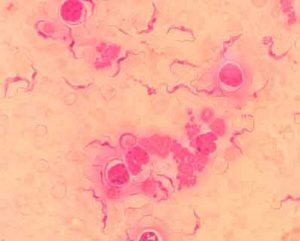Trypanosoma
(Trypanosoma evansi)
Trypanosoma evansi is a protozoal pathogen closely related to African trypanosomes, which causes the disease ‘Surra’ in ruminants, horses and camels. Dogs are highly susceptible to T. evansi infection and they often exhibit severe clinical signs than can lead to death.
| Parasite: Trypanosoma evansi |
| Common name: Trypanosoma |
| Hosts: Ruminants, horses, camels, dogs, cats |
| Location in host: Free in bloodstream |
| Distribution: Asia, Latin America, North Africa |
| Transmission route: Biting insects (tabanids and Stomoxys), iatrogenic, oral transmission |
| Zoonotic: Yes |
Distribution
The disease is distributed in North Africa, the Middle East, Turkey, India, southern Russia, South-East Asia, Indonesia, the Philippines and Latin America.
Clinical signs
Trypanosoma evansi infection in dogs includes fever, anorexia, lethargy, lymphadenomegaly, hepatosplenomegaly, oedema, ascites, petechial haemorrhages, uveitis, oculo-nasal discharge, corneal oedema reminiscent of blue eye caused by canine adenovirus infection, and neurological signs associated with meningoencephalitis.
Diagnosis
The diagnosis of T. evansi trypanosomiasis involves detection of trypomastigote forms of the parasite by cytology of blood, body fluids or tissues by microscopy (Fig 1). Dogs may have anaemia, leukocytosis or leukopenia and thrombocytopenia. Serum biochemistry abnormalities include increased activities or liver enzymes, azotaemia, hypoalbuminemia and hyperglobulinemia. PCR with sequencing are useful for detection of low parasitaemia and for species determination. ELISA, IFA and the card agglutination trypanosomiasis test (CATT) are available for the detection of antibodies against T. evansi.
Treatment
Trypanosoma evansi infection in dogs can be treated with off-label use of diminazendiminazen aceturate (5 mg/kg IM) with variable responses noted. Off-label suramins (70 mg IV in 100 mL 0.9% NaCl TID every third day) lead to the resolution of parasitaemia 3 days later following the second injection in a dog weighting 8 kg [1].

Figure 1 Trypanosoma evansi in a stained blood smear from an infected dog. (Image credit:Dr. B. K. Linh)
Control
Disallowing consumption of raw meat and eliminating dog contact with vectors by using topical repellents and insecticides such as collars and spot-on formulations (e.g. permethrin, flumethrin, deltamethrin).
Public health considerations
Rare zoonosis. To date, five human cases of T. evansi infection have been reported. Livestock are considered primary reservoirs.
References
[1] Defontis M, Rochartz J, Engelmann N, Bauer N, Schwierk C, Buscher VM, Moritz A. Canine Trypanosoma evansi infection introduced into Germany. Vet Clin Pathol. 2012;41:369-374.
